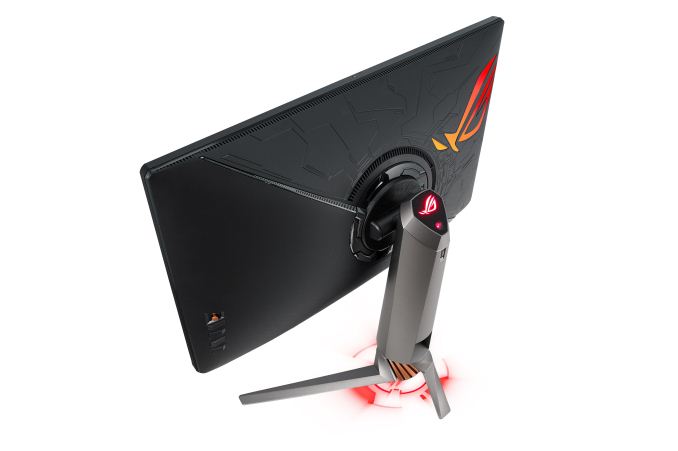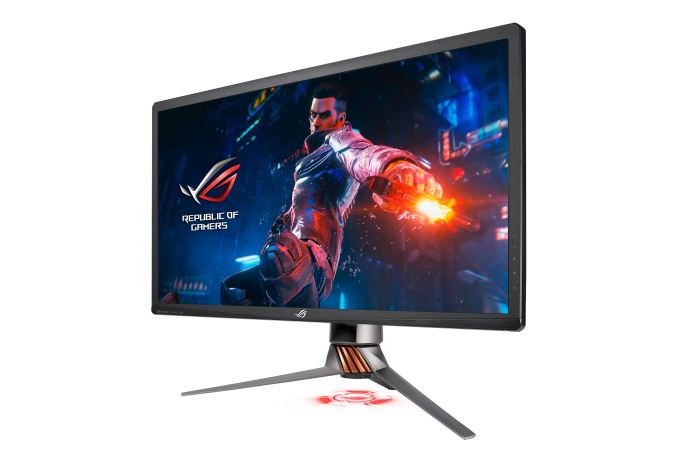The Asus ROG Swift PG27UQ G-SYNC HDR Monitor Review: Gaming With All The Bells and Whistles
by Nate Oh on October 2, 2018 10:00 AM EST- Posted in
- Monitors
- Displays
- Asus
- NVIDIA
- G-Sync
- PG27UQ
- ROG Swift PG27UQ
- G-Sync HDR
The (Asus) G-Sync HDR Experience: Premium Panel for Premium Price
In the end, gamers are given the ultimate guidance with the price point: $2000. The cost doesn't pull any punches, and while it may not be explicitly communicated to consumers, the price is all about the panel functionality, while everything else takes the backseat. Though we can only say this directly about the Asus PG27UQ, this is presumably the case for Acer's Predator X27, which shares the connectivity, large physical design, and active cooling setup.
Some of this is out of Asus's hands, and with the G-Sync HDR module's capabilities and limitations, something that they can only package up and support the best they can. Manufacturers on the display design side would be limited in expanding the basic range of use of G-Sync HDR. Some aspects are even out of NVIDIA's hands when it comes to HDR support in the OS, which goes back to Windows' historically poor management of anything non-SDR and non-sRGB; if the monitors were ready before the Windows 10 April 2018 Update, ease-of-use would've been a big issue.
As one of two current G-Sync HDR implementations, the Asus PG27UQ is also just one of three VESA DisplayHDR 1000 certified products, alongside the Acer counterpart and a Phillips 4K TV, and one of three UHDA Premium certified monitors, alongside two proviz monitors. So by certifications, it would be one of the best HDR PC monitors on the consumer market anyway, G-Sync or otherwise. It seems more likely than not that the 35-inch and 65-inch models are not imminently ready, although resolving firmware issues with FALD backlighting should be a shared investment between them. But for now, G-Sync HDR can only truly stretch its legs in a niche case: single-monitor non-silent PC gaming with HDR titles on NVIDIA G-Sync HDR supporting hardware powerful enough to target 4Kp144 target. The last bit is already niche on its own: the GeForce GTX 1080 Ti was the first card to really hit 60fps on no-compromises 4K, and both AMD and NVIDIA have stepped back from multi-GPU and multi-card solutions.
As an aside, we know now 144fps is perhaps even further out given that NVIDIA's next generation offering of the GeForce RTX 2080 Ti is more-or-less in the Titan V gaming performance bracket, which is to say it's only about 37% faster than the GTX 1080 Ti. The majority of this review was done prior to the RTX 2080 Ti and RTX 2080 launch, but doesn't fundamentally alter the core premise of 4Kp144 being out-of-reach.
And when you're paying more dollars than most people have horizontal pixels on their screen, especially when that price is especially baked in to that use case, that niche becomes extremely relevant. There's no price tiering right now in terms of non-4K G-Sync HDR or non-HDR 4Kp144 G-Sync, so pursuing either combination still leaves you at the $2000 price point. So let's find out if the prospect of playing PC games with the cutting-edge of 2018 visuals measure up.












91 Comments
View All Comments
lilkwarrior - Monday, October 8, 2018 - link
SLI & Crossfire are succeeded by DX12's & Vulkan's explicit multi-GPU mode. Nvidia deleiberately even ported NVLINK (succeeds classic SLI) to RTX cards from Quadro+ cards but without memory pooling because DX12 & Vulkan already provides that for GPUs.Devs have to use DX12 or Vulkan and support such features that is easier for them to consider now that Windows 8 mainstream support is over + ray-tracing that's available only on DX12 & Vulkan.
nathanddrews - Wednesday, October 3, 2018 - link
Still cheaper than my Sony FW-900 CRT was when it was brand new! LOLHixbot - Wednesday, October 3, 2018 - link
Still not better than a fw-900 in many ways. This LCD doesn't have a strobing feature to reduce eye tracking motion blur.nathanddrews - Wednesday, October 3, 2018 - link
No argument there, but my FW900 died, so the options are few...Crazyeyeskillah - Wednesday, October 3, 2018 - link
my fw-900 is also dead in my closet, hoping of resurrecting it one day. Right now I got another excellent crt monitor I found to game on: Sony Multiscan E540 : It's not as big, but god damn is it smooth and flawless.By the time this crt dies, hopefully LCD tech won't be such garbage trying to make workaround for its inferior tech for gaming.
nathanddrews - Thursday, October 4, 2018 - link
Yeah, I've moved on to a Sony C520K for the last ~2 years. In use I think it's far better than my FW900 was in terms of contrast/color plus I'm able to push slightly higher refresh rates, but it's not widescreen. I have bought a couple expensive G-Sync displays, hoping for an adequate replacement, but ended up returning them. I'm really hoping that this CRT lasts until MicroLED hits the market and that mLED can truly combine the best attributes of LCD and OLED without any of the drawbacks.Ironchef3500 - Wednesday, October 3, 2018 - link
100%Tunnah - Tuesday, October 2, 2018 - link
I don't get the point. You don't need the features for desktop work, so this is purely a gaming feature. Why not get an equally capable OLED/QLED at a much bigger size for less money ?Inteli - Tuesday, October 2, 2018 - link
TVs don't support native high refresh rates from sources like monitors do (I think LG's does, but only from USB sources or something like that) or adaptive refresh rates. It's a gaming monitor, so it has gaming-specific features.imaheadcase - Tuesday, October 2, 2018 - link
You answered own question, because its a gaming monitor. You can't find one like this (yet) that offers all the things it does.You like many people are confused on this website about TV vs monitors. A TV equal size, same resolution, is not the same as a dedicated monitor. A LG OLED 55 inch TV looks pretty bland when you use a PC monitor for gaming.